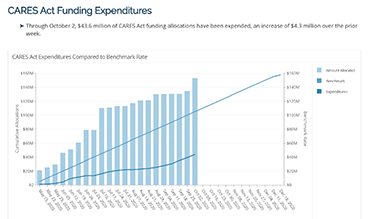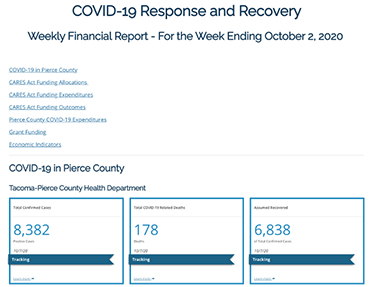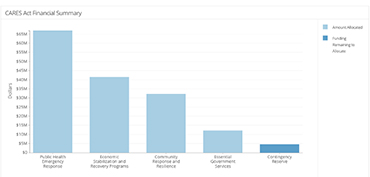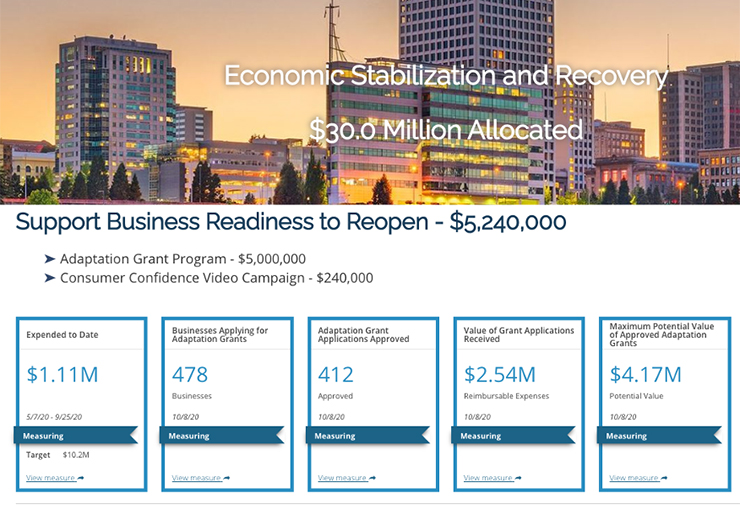Reporting on CARES Act in Pierce County
We know we’re making decisions based on data and fact, which allows our decisions to be precise and effective. We’re not fumbling around — we can pinpoint it quickly, make changes quickly, pivot, and make sure things are working the way they’re intended to.
Julie Demuth
Budget Manager
A wide-ranging approach to internal data sharing has paid off for an innovative public government, Pierce County, Washington.
The pandemic tested the limits of state and local governments in unprecedented ways. At the same time, it has helped validate investments in data programs, as in Pierce County, Washington, that inform operations, budgets, and policy decisions.
Common Data Challenges of the Pandemic
While governments are most often looking for ways to save dollars, cut budgets, and under expend, many found themselves — after receiving CARES Act funds — trying to get millions of dollars out the door as fast as possible. In the case of Pierce County, the effort amounted to dispersing funds totaling more than half of the county’s typical annual budget.
Julie Demuth, Budget Manager, said the pace of effort has been incredible.
“We received $158 million in CARES Act funding that we have to push out to the community in six months,” Demuth said. “Spending that amount of money at this speed has been a bit unprecedented.”
The big challenge public leaders are facing is how to ensure those dollars are effective and equitable. To do that, governments need a way to capture finance, programmatic, and administrative data; integrate all the disparate sources; and serve up real-time insights to decision-makers.
Transforming Existing Investments Into Customizable Solutions
Pierce County launched Tyler’s Enterprise Data Platform in 2018. Since then, it’s used the internal data sharing capabilities, as well as the open data components, to manage and track operational improvement as it relates to departmental performance and the county’s strategic plan.
Having a sustainable process is everything and being able to leverage the technology we already had was huge.
Julie Demuth
Budget Manager
Early in 2020, the team planned on unveiling a new dashboard, powered by the same technology, that would help track the budget to its outcomes. When the pandemic hit, they needed to quickly switch gears. The budget project they envisioned was exactly the approach they needed to track CARES Act spending.
“We quickly realized how we could use the platform to our advantage and deploy this really quickly,” Demuth said.
Within a matter of weeks, the team repurposed their progress on that budget dashboard and consolidated numerous datasets — from the finance, health, emergency management, and economic development departments — into one centralized location.
That dashboard gave county leaders the ability to quickly see financial standings in relation to operations and programs, and it simplified the weekly reporting process. As data is updated in the platform, all the visualizations, performance measures, and charts update automatically. Measures and the other performance management features of the Enterprise Data Platform were designed to help government leaders track progress on their strategic initiatives. Its turnkey nature helps Pierce County leaders monitor how fast dollars are put to use and the outcomes of those allocations.
“We had a rapid turnaround with uploading data and developing a report for the county executive and county council, and the technology made that possible,” Demuth said.
That technology not only provided an internal data sharing platform, but gave county staff the capability to seamlessly publish data publicly, giving residents, businessowners, and others the ability to see progress on the recovery effort for themselves and dive into source data if they choose.
Tapping Into Deep CARES Act Insights
The solution has given stakeholders across the organization the insights to make informed decisions leading to the recovery effort, which ultimately impacts lives and livelihoods in Pierce County.
“I honestly could not imagine going through this process without having the data available online in real time,” Demuth said. “It’d be like operating blindly so to speak. We’d be developing a lot of spreadsheets, tracking things manually. It would never be at the depth and level of detail that we’re able to do it now. Having [Tyler’s Enterprise Data Platform] has made for a collaborative, and a much more accurate, process as well.”
We know we’re making decisions based on data and fact, which allows our decisions to be precise and effective. We’re not fumbling around — we can pinpoint it quickly, make changes quickly, pivot, and make sure things are working the way they’re intended to.
Julie Demuth
Budget Manager
Demuth’s team meets every week with the executive and leadership team, and reports out to the county council every Monday using data from the dashboard. The data allows the team to make quick decisions on whether to reallocate or increase funding to various programs, compare which programs are the most effective, and determine whether policy changes are needed.
The dashboard includes charts, data visualizations, and source data for:
- Funding allocations,
- Funding expenditures,
- Funding outcomes,
- Grant funding, and
- Economic indicators
“To have those meetings and look at real data has been extraordinarily beneficial,” Demuth said. “We know we’re making decisions based on data and fact, which allows our decisions to be precise and effective. We’re not fumbling around — we can pinpoint it quickly, make changes quickly, pivot, and make sure things are working the way they’re intended to.”



Real-Life Outcomes of Data-Driven Response
The data gives county leaders the ability to understand how the pandemic — and their response — is impacting the community, where recovery dollars are making an impact, and target funding toward areas where they hope to see improvement. The county’s CARES Act Funding Outcomes Dashboard shows details on the cost and outcomes of testing, contact tracing, quarantines, and more.
“We’re still in the process of allocating our full funds, and we’re just now starting that exercise of evaluating where we’re projecting to underspend,” Demuth said. “We’re trying to find those programs where there’s high need and we can quickly move those funds to get them into the hands of residents and businesses.”
For example, as the volume of confirmed cases fluctuated in August, leaders in Pierce County dove into the CARES Act dashboard to curb the increase. They found the number of positive cases for 20- to 29-year-olds was rising, and reallocated some funding to target that group and turn that behavior. They also found they were underspending in the public health emergency response, and are pivoting funds to purchase more personal protective equipment, test kits, and other goods they’ll need next year.
“As we allocate funds to new programs or services, we want to be able to look at the financial and operational data and make sure those budget decisions are producing the results we intended,” Demuth said. “If not, can we change how we’re funding, change our program, make changes in our processes?”
It’s the same principle used in many budgeting processes that emphasize outcomes. It also translates to other aspects of the recovery. The county’s recovery programs for economic development initially focused on small- and micro-businesses. As the county monitors the number of applicants and the speed at which dollars are getting out, program leaders can turn the dial to help more business owners.

“The dashboard helps us understand what we’re trying to achieve and whether we’re achieving it,” Demuth said. “It’s given us eyes at a very detailed level.”